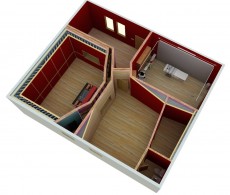Acoustic Treatment Setup in Your Studio or Listening Room
How to Place Acoustic Panels and Sound Absorbing
Material for High Fidelity Listening and Mixing
PART: 1 2 3 4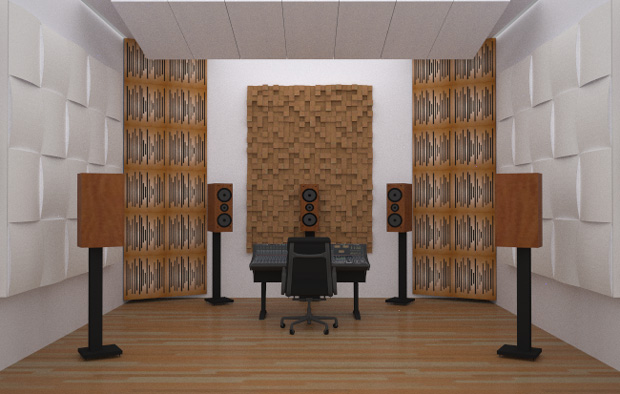
There is no point buying expensive speakers if you’re going to put them in a crappy listening environment.
Despite this, most people skimp on acoustic treatment when setting up their room.
Why? It costs money, they don’t understand it, the spouse hates it — whatever the reason, people are reluctant to throw some acoustic panels on their walls, even though it will make an epic improvement to their sound!
The truth is, you are fighting a battle for sonic clarity. And you may not realize it, because your opponent is invisible.
Your invisible foe: A horde of acoustic distortions who haunt your room. They distort the sound you’re trying to hear, surrounding you in a sea of sonic lies as your ears struggle to hear the truth.
Treat your room wrong (or not at all), and you’ll loose the war, forcing your ears to suffer a life in low-resolution limbo.
This tutorial will give you strategies to defeat the distortions and liberate your ears.
I’ll show you how to apply treatment to a critical listening, mixing or control room. If you have a hi-fi room or home theater, much of this advice applies but you may opt for a livelier room with more diffusion and less absorption (I’ll include tips for this).
-
If you don’t want to read this whole article you can jump to the part that interests you:
- Three example acoustic treatment layouts.
- Kill early reflections with acoustic panels at your first reflection points.
- Bass absorption — your siege artillery.
- Making your room disappear with extreme broadband absorption.
- Adding a sense of space with diffusion.
- How to balance absorption and diffusion to achieve a musical sounding room.
- How much liveliness does your room need? (decay / reverb time suggestions)
- A cheat code for acoustic treatment coverage in domestic rooms (listening rooms, home theaters, home studios).
- Guidelines for total treatment coverage in high end critical listening rooms (professional control rooms and mastering studios).
Example room setups (critical listening / mixing rooms)
Below are three example rooms we’ll be looking at. To see how I chose the listening position and speaker placement, check out our room and speaker layout guide.
Room 1 (Left): A lightly treated 2-channel mixing room with basic absorption and diffusion (typical in a project or home recording studio). You could use the same arrangement for a hi-fi listening room. This room shows only the minimum treatments required. It’s a good starting point but additional acoustic panels should be added to tame excessive liveliness and prevent potential flutter echo in the rear half of the room.
Room 2 (Center): A 5.1 surround sound mixing room using commercially available acoustic panels and bass traps. You could use a similar arrangement for a home theater, but you would likely incorporate more diffusion and place the listening position and speakers closer to the back of the room.
Room 3 (Right): A 5.1 surround sound control room setup for critical listening. It uses broadband bass absorption systems build into the walls (giant DIY bass traps). You’ll see two versions of this setup: one with a purely absorptive rear wall (best for critical listening), one with a rear wall diffuser (to add a bit more liveliness to the space).
Room 3 is designed for mixing surround sound music, but a similar setup could be used for film post production and surround media mastering.
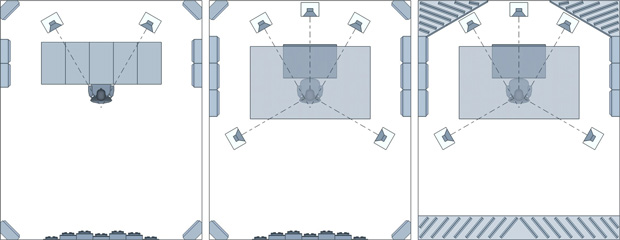
Room correction software is NOT your secret weapon!
Alas, you can’t simply apply digital room correction to fix your acoustics.
Room EQ can tame some issues, but it can’t correct for long reverberation times or comb filtering caused by strong early reflections (like those nasty reflections produced by speaker-boundary interference).
To tame these problems you have two weapons in your arsenal: smart room layout and acoustic treatment.
Kill early reflections by placing acoustic panels at your first reflection points
If you can only apply one treatment to your room, and you want the most bang for your buck, here’s what to do: Slap some acoustic panels on your first reflection points.
Why? To create a sweet spot around your listening position, you need to treat early reflections from nearby boundaries. Left untreated, early reflections will combine with the direct sound from your speakers, causing comb filtering (or “time smearing”).
Comb filtering is a type of acoustic distortion. It causes coloration, masks details in your media and prevents accurate localization.
Subtle comb filtering can sound musical. It’s a natural part of reverberation. But harsh comb filtering is pure evil — your worst enemy in the battle for sonic clarity.
Kill the comb, and you will hear massive improvements in both clarity and imaging.
Your weapon: Acoustic treatment material (typically broadband absorption).
Your points of attack: First reflection points.
If you’re subscribed to email updates I’ll send you a tutorial on how to find and treat your first reflection points in the near future.
Ideally, you would create a reflection free zone (RFZ) around the listening position. A RFZ is simply a zone where you don’t hear early reflections. When you’re in the zone, you hear the direct sound from your speakers without the interference of reflections from nearby surfaces.
At the very least you need to treat the first reflection points on your side walls, and the part of the ceiling above the listening / mix position.
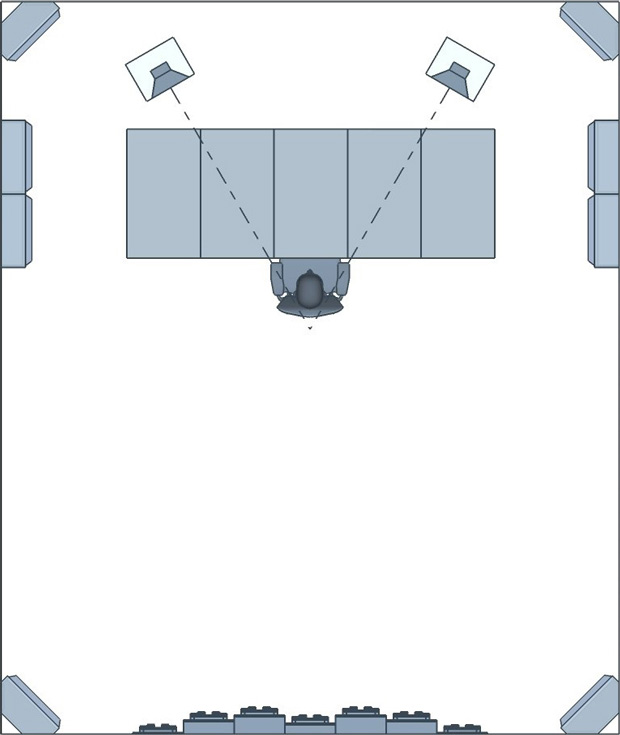
 Minimum acoustic treatment setup in stereo and surround sound mixing rooms (lightly treated). Sidewall first reflection points (left and right of listening position) are treated with broadband bass traps, but other acoustic panels could work. At the ceiling first reflection points, the outline of a ceiling cloud is shown.
Minimum acoustic treatment setup in stereo and surround sound mixing rooms (lightly treated). Sidewall first reflection points (left and right of listening position) are treated with broadband bass traps, but other acoustic panels could work. At the ceiling first reflection points, the outline of a ceiling cloud is shown.
The easiest and cheapest way to treat your first reflection points is to use broadband absorption. 4-6 inch thick rockwool or rigid fiberglass acoustic panels will do the trick. 2 inch thick panels are an absolute minimum.
In most cases you’re better off with thicker panels (e.g., 8 inches +) because they absorb to lower frequencies. You can also mount your panels with an air gap to lower the minimum frequency absorbed.
For critical listening and control rooms, I usually recommend thick broadband absorption (or broadband bass traps) at these first reflection points. The same goes for mastering studios. There are exceptions, of course, like Blackbird Studio C, designed by George Massenburg. His mixing / mastering room uses 100% diffusion.
For hi-fi listening rooms and home theaters you may not want total absorption at the first reflection points. In these rooms a combination of absorption and diffusion is popular.
In control rooms an absorptive ceiling cloud is typically used above the listener. Hi-fi rooms and home theaters often use a mix of absorption and diffusion on the ceiling.
Many treatments are available as 2′ x 2′ acoustic ceiling tiles which fit into a standard false ceiling (dropped ceiling grid).
If you’re doing a renovation or building your room from the ground up, you can build broadband absorption right into your walls and ceiling (to learn how, see the book Recording Studio Design by Phillip Newell).
Bass traps and low frequency absorption — your siege artillery
All small, untreated rooms are haunted by an acoustical monster I call the low end beast. The beast refers to the total accumulation of mayhem at low frequencies.
Sources of mayhem include room modes, the speaker-boundary effect, and any other acoustic distortion caused by bass waves trying to exist in small rooms.
The bass beast plagues your room, giving it an uneven frequency response and long decay times at low frequencies.
How do you know if your music and mixes are under attack? If your bass range sounds unbalanced and muddy, that’s a sure sign. If you’re in a small, untreated room — even if you think nothing is wrong — the beast is ever present.
To tame the low end beast you have two weapons at your disposal: speaker placement and bass absorption, or “bass trapping”. Apply both, and you’ll have a tighter sounding low end with enhanced clarity.
Weapon 1: Here’s how to lay out your room and speakers to manage bass.
Weapon 2: Here’s a big fat tutorial on how to arrange bass traps.
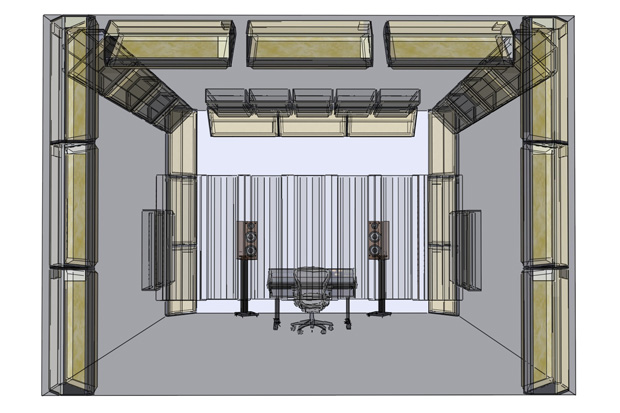
- If you prefer a DIY approach to bass absorption, here’s what I recommend for critical listening and control rooms:
- See Phillip Newell’s book, Recording Studio Design
(Chapters 5, 13, 16 and 17) for details on how to create a neutral sounding control room. A big part of this is broadband bass absorption. For this, the example room plan below uses hanging “waveguide” panels in the style of studio designer Tom Hidley.
- If you’re not flush mounting your speakers, you can build giant, broadband, floor to ceiling bass traps in the front wall-wall corners of your room (behind your speakers). If you don’t want the front of your room to be dead, you can surface these bass traps with wood slats, drywall or MDF (medium density fiberboard). This way they are reflective at mid-high frequencies, absorptive at low frequencies. The example room layout below uses this approach.
- If you can, add broadband bass traps to the ceiling, or turn your entire ceiling into a giant bass absorber (see Chapters 5, 13 and 16 of Recording Studio Design
).
- Turn your rear wall into a huge bass trap to help deal with rear wall SBIR and modal bass buildup. If you use the superchunk approach, make your absorptive rear wall at least 18 inches thick. In the example room plan below, the rear wall is designed to prevent slapback and absorb early reflections over most of the audible spectrum. It’s a massive broadband absorber, similar to the rear wall of a Hidley or Non-Environment (NE) control room.
There are ways to get the same absorption in less space by using pressure activated devices (like panel absorbers or limp membrane bass traps) to tackle the lower bass frequencies. But coosing the right pressure absorbers for your room can be tricky. Give me a shout if you need help with this.
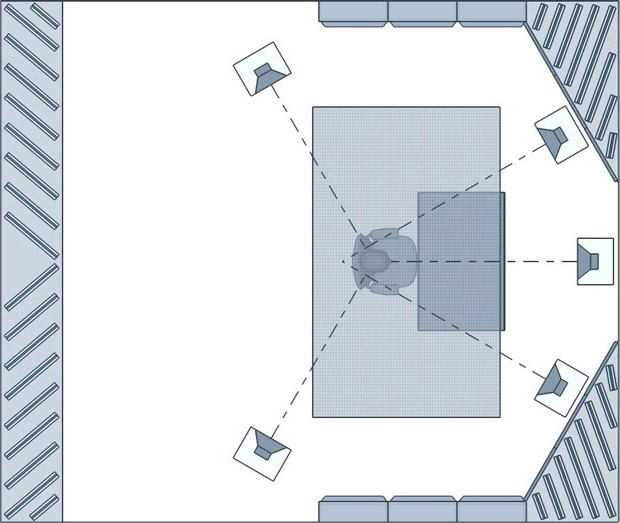
Broadband absorption (sound dampening material) taken to the extreme
Here’s an acoustic treatment strategy for the most hardcore critical listening.
Imagine for a moment that you’re a pro audio engineer, mixing or mastering music for a living. Now, imagine you have some tough clients — the robot mafia — and your life literally depends on your ability to hear fine details.
You want to hear the music with maximum transparency. Pure signal, no noise. Pure music, no room. You want an environment designed for hardcore critical listening.
In this case, your main treatment strategy would be to create an acoustically neutral environment using LOTS of broadband absorption.
This is typical in studio control rooms where the ideal is an even frequency response, even decay times and tight, focused imaging. But as you’ll soon see, approaching this ideal using just absorption requires an outrageous amount of low frequency treatment!
Making your ceiling disappear using absorption
Control rooms usually pair a reflective (e.g., wood) floor with an absorptive ceiling.
In the example room setups you can see the outline of an absorptive ceiling cloud above the listener. This is the minimum ceiling treatment required — just enough to create a reflection free zone around your listening position.
But in a perfect critical listening room the ceiling would be a giant broadband bass absorber, perfectly absorbing all reflections, so it sounds as if there is no ceiling at all. The same can be said about the rear and side walls.
Making your room disappear
In the ideal world your room acoustics would disappear, so that you’re only hearing the pure sound coming from your speakers. Of course you don’t want a complete anechoic chamber… just a room that sounds neutral when you’re listening through speakers.
This the design philosophy behind the Non-Environment (NE) control room.
But a problem arises when we try to create a neutral room, or even just a well balanced room: It’s hard to reduce decay times at low frequencies, but easy to render your room dead at high frequencies.
In other words, high frequencies are easy kill by accident… but as hard as we may try, most of us can never kill the low end beast. We can only tame it.
If you install too much mid-high frequency absorption, but not enough bass traps, your room is going to sound awkward: dull and sterile in the high end, sloppy and boomy in the low.
Low frequency control is the limiting factor when creating neutral sounding critical listening rooms.
Unless you can bass trap the crap out of your room, you can forget about having a truly neutral sounding room. Instead, focus on having a balanced, musical sounding room.
In the next sections you’ll see how to achieve balance by adding diffusion to the mix.
Adding a sense of space with diffusion
Here’s where room treatment gets fun.
Sound diffusers let you treat reflections without absorbing them, so you can retain some life in your room. Diffusion also adds an airy, musical quality to your room acoustics.
Consider diffusers on your rear wall if it’s at least 10 feet (3 meters) behind your listening position.
Professional recording studio control rooms tend to use thick bass absorption on the rear wall. But many use diffusers over top to scatter higher frequencies, giving an added sense of spaciousness.
This way you can absorb bass reflections, without sucking all the liveliness out of your room.

Rear wall diffusion is the standard in live end, dead end (LEDE) and reflection free zone (RFZ) control rooms.
In hi-fi listening rooms, diffusers on both the rear and front wall is common. This gives an aural illusion of pushing the walls out, making the room feel bigger.
In home theaters, I definitely recommend a combination of absorption and diffusion. Diffusion on the back wall and ceiling is popular.
Here are the diffusers shown in the example room setups. On the rear wall, you see an array of 7 Leanfuser panels (Leanfractal panels would be even better). I designed these open source, optimized stepped diffusers specifically for DIY builders. You can download the DIY plans here.
Alternatively, you can use QRD diffusers on the rear wall. The Diffractal is ideal for this. It’s a fractal QRD diffuser by RPG, providing broadband diffusion throughout the audible spectrum.
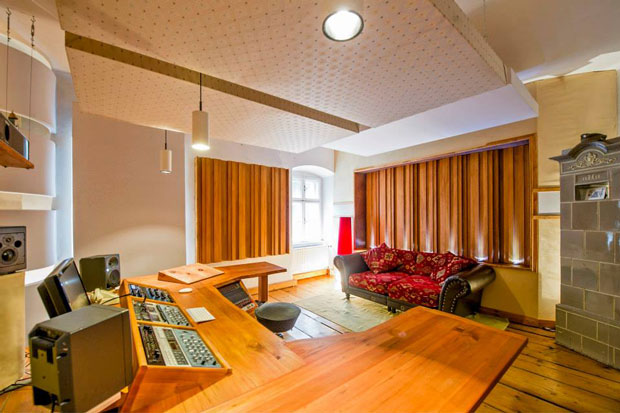 Our Leanfuser optimized sound diffusers (download the blueprints here) at the rear end of Castle Mastering Studio at Castle Wildberg, Upper Austria. Built by Alexander Jöchtl, aka Audiobomber. Photo by Karin Lohberger Photography.
Our Leanfuser optimized sound diffusers (download the blueprints here) at the rear end of Castle Mastering Studio at Castle Wildberg, Upper Austria. Built by Alexander Jöchtl, aka Audiobomber. Photo by Karin Lohberger Photography.
The balance: absorption, diffusion and “reverberation” time (RT60)
-
Finding the right balance of absorption and diffusion in your room is part science, part black magic. Here are some guidelines:
- Start by mounting bass absorbers and treating your first reflection points.
- Apply treatment to the ceiling and all walls of your room, if you can.
- To prevent slap / flutter echo you usually want to avoid any large areas of bare wall or ceiling.
- Aim for left-right side wall symmetry whenever possible.
- I advise against carpeting the floor, but a small area rug can be put under the listening position to absorb first reflections from the floor. Carpet absorbs high frequencies much more than mids and lows. When over used it can have a cheapening effect on your sound, making your room sound dull.
If accuracy is not your sole concern, a diffuse sound field can add a lively, musical quality to your room. This is often desired in hi-fi listening rooms and home theaters.
To achieve this, you can start by covering 20 percent of the total wall and ceiling surface area with broadband absorption (Ideally over 4 inches thick. 2 inches is an absolute minimum). Then, cover 20 to 30 percent of the wall and ceiling surface area with scattering or diffusive materials.
You can then run acoustic measurements to test the decay times in your room, and tweak the absorption / diffusion coverage as needed.
Just make sure the decay times are suitable for your room!
(I’ve given you some guidelines below.)
Reverberation and decay time
In architectural acoustics we use reverberation time (T60 or RT60) to measure liveliness. RT60 is the time it takes for the sound pressure level to decay by 60 dB.
But small rooms (like most listening / mixing rooms) don’t have true reverberation, and it’s not always possible to measure 60 dB of decay. So, in small room acoustics we often measure the 30 dB decay (T30) as a proxy for reverberation time.
Room EQ Wizard (free software) can be used to measure the decay times, but you can get a feel of the liveliness in your room simply by clapping.
If you’d rather not do the acoustic measurements, or if you want help achieving the right level of liveliness in your room, hit me up for a room acoustics assessment and personalized room treatment plan.
How much liveliness does my room need?
In control rooms and listening rooms, typical decay time (T60) values are 0.2 to 0.5 seconds between 250 Hz to 4 kHz. If you’re in a particularly small room (say, a bedroom), aim for 0.1 to 0.3 seconds. The smaller the room, the shorter the decay times should be.
The most accurate control rooms are highly damped with reverberation times less than about 0.3 seconds.
In hi-fi listening rooms, optimal T60 values depend on your listening preferences.
If you listen mostly to classical music, consider a more live room with decay times of 0.4 to 0.5 seconds. If you only listen to multi-track recordings comprised of close-miked instruments or electronic elements, aim for 0.2 to 0.3 seconds.
If you like to mix it up with your genres, 0.35 seconds could be a good sweet spot (assuming a listening room with a volume of about 3500 cubic feet).
In surround sound rooms and home theaters, Dolby recommends shorter decay times: 0.2 to 0.4 seconds.
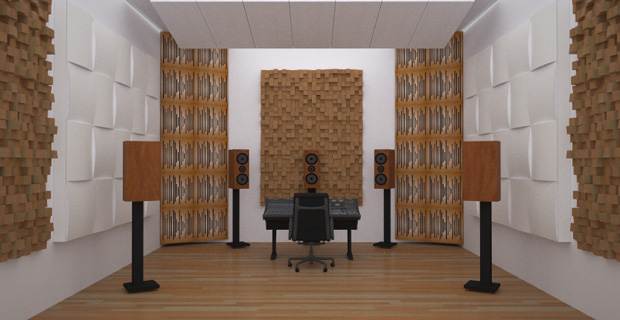
Shown in both above and below room layouts: Large corner DIY bass traps are surfaced with Vicoustic Wave Wood panels to provide scattering at mid-high frequencies. Ideally, heavy duty bass absorption would be built into the rear wall and ceiling. Vicoustic Multifuser wood diffusers are shown on the front and side walls. Assuming the rear wall is treated, diffusers on the front wall are not essential — but they make the room sound more spacious and enveloping, making it an inviting space for spontaneous musical activities like practicing or recording. Diffusers would also be mounted on the rear wall.

Cheat code for acoustic treatment coverage in domestic rooms (home studios, listening rooms, home theaters)
Here’s a cheat code you can use for treating your typical domestic room (whether it’s a hi-fi room, home theater or home recording studio): Cover 22 to 25% of the interior surface area with acoustic treatment.
That would be the total coverage provided by bass traps, absorptive acoustic panels and diffusers. I gave tips on absorption vs diffusion coverage above when we looked at how to achieve a balanced sounding room.
To see how to use this cheat code in a home studio, check out Rod Gervais’ book, Home Recording Studio: Build It Like the Pros.

This cheat code is just a guideline. It leaves a lot open for interpretation because your room has unique needs and constraints. In your room, the total volume taken up by acoustic treatments will depend on your budget and how much space you’re willing to give up.
When treating a domestic sized room, space and money are common constraints. Too bad bass treatment loves to consume both!
Guidelines for high end rooms (professional control rooms and mastering studios)
If you’re building a high end critical listening room, like a control room or mastering studio, prepare to sacrifice an embarrassing amount of space for acoustic treatment! And be sure to utilize your ceiling — you can fit a lot of treatment up there.
With the previous cheat code we were referring to room surface area. Now, we’re looking at acoustic treatment as it relates to room volume.
-
The following guidelines are for heavy duty room treatment. They assume:
- You want an accurate monitoring/mixing environment with very tight bass control.
- Deep, DIY broadband bass trapping systems are used (like hanging Hidley panels or superchunk traps). Note that you can potentially use less space if you incorporate tuned bass traps (like panel absorbers) or other high quality commercial bass traps that act on frequencies down to 50 Hz (doing this right usually requires a room acoustics analysis).
In rooms between 500 to 1000 square feet, 30 to 40% of the room volume may be enough to meet the listening needs in a professional studio environment. In larger rooms you can treat less percentage of the room volume.
Ouch! Most people can’t stomach the thought of sacrificing this much space! The reality is that most of us have to compromise. This is why I showed you the cheat code in the previous section.
If you have space for deep broadband bass trapping systems, you can see how to build them in Phillip Newell’s book, Recording Studio Design

If space is sacred to you, I recommend high quality commercial bass traps that achieve excellent absorption in minimal space. These will be need to be pressure absorbers, not simply chunks of fiberglass or acoustic foam.
Pressure absorbers are space efficient but tend to cost more. To properly specify them I suggest a room acoustics analysis.

What should I expect to hear if I treat my room right?
The combination of strategic speaker placement and acoustic treatment will elevate your listening experience.
Use this dual-pronged attack, whether your goal is critical listening or high fidelity bliss.
Early reflection control combined with careful speaker placement will give you a transparent sound stage with tight, focused imaging.
Smart choice of listening position, speaker placement and bass absorption will give you a tighter, more even low end with better bass extension.
An acoustically treated room makes it easier to emotionally connect with your music, or get into the creative flow a mix!
You will experience a new level of depth and clarity in your media, letting you hear crisp details and the full dynamic range in high fidelity.
If you’re a hi-fi audiophile, you will finally hear the true voice of your speakers. You will be able to close your eyes and be transported into the music… as if you’re listening live, in the room where the song was recorded, surrounded by your favorite musicians.
If you’re a recording, mixing or mastering engineer, you will be able to critically listen in higher resolution, letting you produce better mixes and masters that translate better to other systems.
If you’re a producer or studio owner, the setup of your studio can affect your bottom line. With a better monitoring / mixing environment you can attract better clients and provide higher quality results for them.
Now that you have a plan of attack, you can prepare for battle against your invisible foes: Room modes, boundary interference, corrupt early reflections, flutter echo — don’t let these distortions win the war and poison your ears with their distorted propaganda.
Take up arms against them by strategically treating your room.
If you do nothing, your ears will suffer a life in low-res limbo. But if you treat your room right, your media will shine through. And your ears will thank you.
PART: 1 2 3 4
| < Room & Speaker Setup Tutorial | Bass Trap Placement Guide > |
Do you know someone who might find this guide useful? If so, please share it :-)
by Tim Perry

